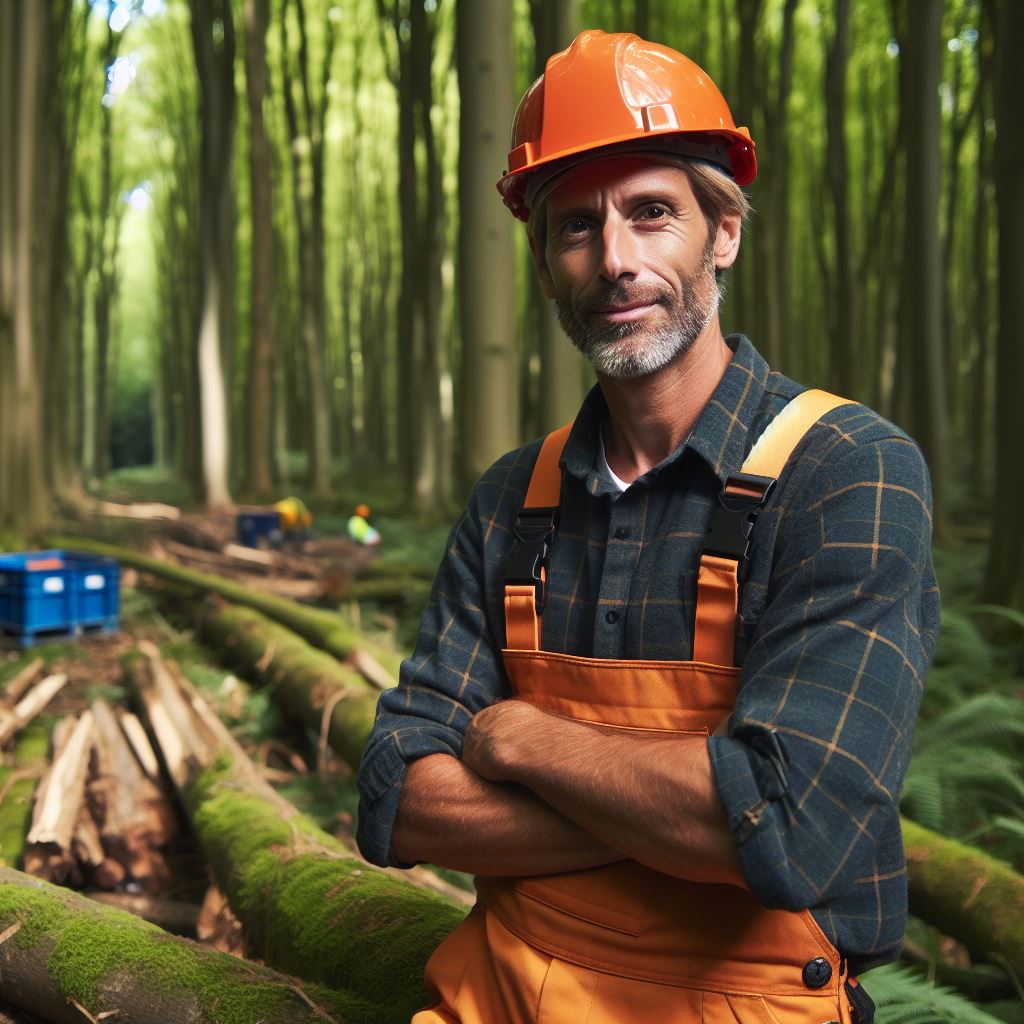Introduction
Climate change is reshaping the landscape, impacting UK forestry roles. Sustainable practices are vital to combat its effects.
Forests play a crucial role in sequestering carbon, mitigating climate change. As temperatures rise, pests and diseases threaten tree health, demanding adaptive strategies.
Forestry roles evolve, focusing on resilient tree species and ecosystem restoration. The UK must prioritize sustainable forestry to safeguard biodiversity and ecosystem services.
Forests, acting as carbon sinks, aid in reducing greenhouse gas emissions.
Addressing climate change is imperative, and the forestry sector plays a pivotal role. It is not just about trees; it is about preserving the delicate balance of our environment.
Sustainable forestry practices are the key to a resilient future in the face of climate uncertainties. The time to act is now.
Overview of UK Forestry
The UK forestry industry: size and significance
The UK forestry industry is significant in terms of size and importance to the environment.
- The forestry sector in the UK covers about 3.17 million hectares of land.
- Forests make up 13% of the total land area, contributing to the country’s green spaces.
- Woodland covers vary across different regions, with Scotland having the largest forested area.
Role of forests in carbon sequestration, biodiversity conservation, and other environmental benefits
Forests play a crucial role in carbon sequestration, biodiversity conservation, and other environmental benefits.
Carbon Sequestration
- Forests act as carbon sinks, absorbing and storing carbon dioxide, a major greenhouse gas.
- Through photosynthesis, trees convert carbon dioxide into oxygen, mitigating climate change.
- The UK’s forests absorb around 10% of the country’s total carbon emissions yearly.
Biodiversity Conservation
- Forests provide habitats for a diverse range of plant and animal species.
- They support complex ecosystems, promoting biodiversity and preserving rare and endangered species.
- Woodlands also act as corridors, enabling the movement of wildlife and genetic exchange.
Other Environmental Benefits
- Forests help regulate water cycles, preventing flooding and droughts by absorbing and releasing water.
- They improve air quality by filtering pollutants and reducing the impact of urbanization.
- Woodland areas offer recreational opportunities, promoting physical and mental well-being.
- Afforestation projects contribute to landscape restoration and sustainable land use.
To summarize, the UK forestry industry plays a crucial role in the country’s environment and economy. With millions of hectares of forests, the sector significantly impacts carbon sequestration.
Forests support biodiversity, providing habitats and preserving rare species. Environmental benefits of woodlands include water regulation, air purification, and recreational opportunities.
Efforts in afforestation and sustainable land management contribute to a greener and healthier UK.
Impact of climate change on UK forests
How climate change affects UK forests
Climate change has a profound impact on UK forests, affecting both temperature and precipitation.
Rising temperatures and changing rainfall patterns alter the growing conditions for trees, leading to diverse consequences.
- Warmer temperatures can influence the distribution and abundance of tree species, causing shifts in forest composition.
- Changes in precipitation patterns, such as more intense rainfall events, can increase the risk of soil erosion and flooding.
- Extended periods of drought can stress trees, making them more susceptible to diseases and pests.
Increased risk of pests, diseases, and wildfires in UK forests
- Warmer temperatures and altered rainfall patterns create favorable conditions for the spread of pests and diseases.
- For example, the pine processionary moth, which damages pine trees, has seen its range expand northward in recent years.
- Similarly, the ash dieback disease, caused by a fungus, has had devastating effects on ash trees across the country.
- The increased risk of wildfires is also a concern, as drier conditions can promote the ignition and spread of fires.
Understanding the impacts of climate change for effective forest management
- Forest managers need to adapt their practices to mitigate the risks and protect the health of the forests.
- Monitoring and early detection of pests and diseases are vital for implementing control measures in a timely manner.
- Improving forest resilience through appropriate tree species selection and proper forest structure can reduce vulnerability to climate-related stressors.
- Collaboration between researchers, policymakers, and forest managers is essential to develop adaptive strategies and share knowledge.
Essentially, climate change has significant implications for UK forests.
Temperature and precipitation changes, along with increased risks of pests, diseases, and wildfires, pose challenges for forest management.
By recognizing and understanding these impacts, it is possible to develop effective strategies to mitigate and adapt to the changing conditions.
Safeguarding the UK forests is vital for ecological balance and societal gains, such as timber production, carbon sequestration, and recreation.
Read: UK Crop Farming: Trends and Techniques
Changing forestry practices
Need for adapting forestry practices to climate change
In order to effectively address the impacts of climate change on UK forestry, it is crucial to adapt forestry practices to mitigate and adapt to these changes.
Sustainable forestry techniques
Embracing sustainable practices is essential for minimizing the negative impacts on forests and ensuring their long-term viability.
Selective logging is one such technique that can reduce ecosystem disturbance and maintain forest integrity.
Agroforestry is another technique to curb the impacts. This approach involves integrating trees with agricultural crops or livestock to provide multiple benefits.
Agroforestry systems enhance soil fertility, conserve water, and sequester carbon, making them a valuable tool for climate change mitigation and adaptation.
Role of tree species selection, reforestation, and afforestation in building resilient forests
- Tree species selection: Choosing appropriate tree species that can withstand changing climatic conditions is crucial. Species that are more resilient to drought, pests, and diseases should be prioritized to ensure the long-term health and productivity of forests.
- Reforestation: Planting trees in areas where forests have been previously cleared helps restore ecosystem functions and enhance carbon sequestration. Reforestation efforts can also improve habitat connectivity and support biodiversity conservation.
- Afforestation: Creating new forests in areas that were not previously forested can help expand forest cover and increase carbon sequestration. Afforestation can also provide additional ecosystem services like flood control and water purification.
By implementing these strategies, UK forestry can build resilient forests that are capable of withstanding the challenges posed by climate change.
Read: UK Farming Subsidies: Understanding the Basics
Personalized UK Career Consulting
Receive tailored career guidance designed just for you. Get actionable steps and expert support to boost your career in 1-3 days. Take control of your career now.
Get Started
Role of forestry professionals in climate change mitigation
Forestry professionals play a crucial role in addressing climate change and mitigating its impact. They have various roles and responsibilities that are essential in this regard:
Forest Monitoring, Data Collection, and Research
Forest monitoring is an integral part of understanding the effects of climate change on forests.
Forestry professionals collect data on various parameters such as tree growth, biodiversity, carbon sequestration, and soil health.
This data helps in identifying trends and patterns, which further aids in developing effective strategies for climate change adaptation and mitigation.
Research activities conducted by forestry professionals are crucial for improving our understanding of climate change and its impacts on forests.
They study the effects of rising temperatures, changes in precipitation patterns, and increased carbon dioxide levels on forest ecosystems.
This research provides valuable insights into how forests can be managed to enhance their resilience to climate change.
Sustainable Forest Management
Forest managers play a vital role in ensuring sustainable forest management practices that can mitigate climate change.
They develop and implement strategies to conserve forests, promote biodiversity, and restore degraded areas.
By actively managing forests, they can enhance their ability to sequester carbon dioxide from the atmosphere, thus reducing greenhouse gas emissions.
Tree surgeons, also known as arborists, are responsible for the care and maintenance of trees.
They play a critical role in mitigating climate change by managing tree health, preventing the spread of pests and diseases, and promoting the growth of new trees.
Their expertise ensures that forests remain healthy and resilient, which is crucial for climate change adaptation.
Conservationists work towards protecting and preserving forest ecosystems, thus contributing to climate change mitigation.
They focus on conserving forest habitats, promoting sustainable land use practices, and advocating for policies that safeguard forests.
By preserving intact forests and preventing deforestation, they help in maintaining the carbon storage capacity of forests and reducing emissions from land-use change.
Role of tree species selection, reforestation, and afforestation in building resilient forests
Forestry professionals play a crucial role in implementing climate change mitigation strategies.
They actively participate in initiatives such as afforestation and reforestation, which involve planting trees in areas where forests have been lost.
These activities not only help in carbon sequestration but also contribute to ecosystem restoration and the provision of various ecosystem services.
Forestry professionals are also involved in developing and implementing sustainable forestry practices that reduce greenhouse gas emissions.
They promote techniques like reduced impact logging, which minimizes the environmental impact of timber harvesting.
They also advocate for the use of alternative materials that require fewer natural resources, thus reducing the pressure on forests.
Basically, forestry professionals have a central role in addressing climate change and ensuring the sustainable management of forests.
They expertise in forest monitoring, collecting data, researching, and practicing sustainable forest management, contributing to climate change mitigation and building resilient ecosystems.
Read: The Evolution of Fishing in the UK: A Journey
You Might Also Like: Seasonal Fishing in the UK: A Fisherman’s Guide
Opportunities in the UK forestry sector
The UK forestry sector offers a range of career opportunities for individuals passionate about climate change.
Unlocking Career Opportunities in the UK Forestry Sector
Climate change-related roles in the sector focus on environmental conservation, carbon sequestration, and sustainable forest management.
Forest managers play a vital role in adapting forest ecosystems to the impacts of climate change and mitigating its effects.
Your Dream Job Starts with a Perfect CV
Get a tailored CV and cover letter that captures your unique strengths and stands out in your industry. Let us help you make an unforgettable first impression.
Get StartedSkilled professionals in forest management are in high demand due to the need for sustainable and resilient forest ecosystems.
Ecological restoration specialists are essential for mitigating the damage caused by climate change, restoring biodiversity, and improving forest health.
Rising Demand for Expertise in Forest Management, Ecological Restoration and climate change adaptation
Climate change brings forth exciting prospects in the UK forestry sector. Professionals skilled in climate change adaptation and mitigation are in high demand.
The demand is increasing as forests face the challenges of a changing climate.
The role of skilled professionals in forestry becomes increasingly crucial for sustainable environmental management.
Educational Pathways and Certifications for Aspiring Forestry Professionals
Many UK universities and colleges offer forestry programs, laying a foundation for a sector career. A forestry degree imparts skills to tackle climate change in forest management.
Forest Stewardship Council (FSC) Certification, like SAF certifications, showcases expertise in sustainable practices.
FSC ensures responsible forest management, considering environmental, social, and economic aspects.
The SAF and similar organizations boost forestry career prospects. Continuing education, workshops, and specialized courses aid climate change adaptation knowledge.
Internships, volunteering, and networking with environmental groups provide hands-on experience. Building a professional network opens doors to climate change-related roles in forestry.
Staying informed on climate change policies and regulations is vital for forestry aspirants. Knowledge of government initiatives aligns career goals with national priorities.
Collaboration with charities and the private sector funds climate change projects. Skills in data analysis, GIS mapping, and remote sensing enhance forestry job prospects.
Read: Modern Fishing Gear: UK Fishermen’s Toolkit
Conclusion
The symbiotic relationship between UK forestry and climate change mitigation underscores the crucial role of sustainable land management.
Summarizing the key points, sustainable forestry practices emerge as the linchpin, offering a pathway to address environmental challenges.
The multifaceted responsibilities of forestry professionals encompass not only combating climate change but also nurturing biodiversity and protecting ecosystems.
Emphasizing the pressing need for sustainable forestry practices, the role of these professionals becomes paramount in navigating the evolving climate scenario.
The call to action is compelling—urge readers to delve into the rich landscape of forestry careers, fostering awareness, and actively participating in sustainable land management.
As climate change intensifies, the narrative amplifies the transformative impact of collective efforts, accentuating the urgency for sustainable practices and the pivotal role of individuals in shaping a resilient and healthier planet.
[E-Book for Sale]
500 Cutting-Edge Tech Startup Ideas for 2024 & 2025: Innovate, Create, Dominate
$19.99 • 500 Tech Startup Ideas • 62 pages
You will get inspired with 500 innovative tech startup ideas for 2024 and 2025, complete with concise descriptions to help you kickstart your entrepreneurial journey in AI, Blockchain, IoT, Fintech, and AR/VR.




